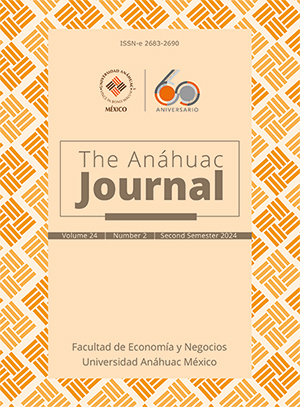Volatilidad y selección de inversión en un modelo de crecimiento económico
Contenido principal del artículo
Resumen
La volatilidad macroeconómica pude afectar el crecimiento de largo plazo a través de sus efectos sobre el ahorro agregado e inversión. En este artículo se desarrolla un modelo de crecimiento económico en el cual las industrias en base a la volatilidad macroeconómica y las restricciones de crédito del sector financiero tienen la posibilidad de dividir su riqueza en inversión de corto plazo frente a una inversión de largo plazo la cual contribuye más al crecimiento de la productividad. El modelo se evalúa empíricamente para México mediante un modelo econométrico dinámico de ajuste parcial.
Downloads
Detalles del artículo
Sección

Esta obra está bajo una licencia internacional Creative Commons Atribución-NoComercial-CompartirIgual 4.0.
The Anáhuac Journal se distribuye bajo Licencia Creative Commons Atribución-NoComercial-CompartirIgual 4.0 Internacional.
Cómo citar
Referencias
Acemoglu, D. y Zilibotti, F. (2001). “Productivity Differences.” Quarterly Journal of Economics,116, 563-606. https://www.jstor.org/stable/2696473
Aghion, P. y Howitt, P. (2009). The Economics of Growth. The MIT Press.
Aghion, P. y Marinescu, I. (2007). “Cyclical Budgetary Policy and Economic Growth: What Do We Learn from OECD Panel Data?” (mimeo). Harvard University.
Aghion, P., A. Banerjee y Piketty, T. (1999). “Dualism and Macroeconomic Volatility.” Quarterly Journal of Economics, 114, 1359-1397. https://doi.org/10.1162/003355399556296
Aghion, P., Hemous, D. y Kharroubi, Enisse. (2009). “Credit Constraints, Cyclical Fiscal Policy and Industry Growth” (mimeo).
Aghion, P., Angeletos, G. M., Banerjee, A. y Manova, K. (2005). “Volatility and Growth:Financial Development and the Cyclical Behavior of the Composition of Investment” (mimeo). Harvard University.
Angeletos, G.M. (2003). “Private Equity and Idiosyncratic Investment Risk in the Neoclassical Growth Model” (mimeo). MIT.
Barlevy, G. (2007). “On the Cyclicality of Research and Development.” American Economic Review, 97, 1131-1164. https://doi.org/10.1257/aer.97.4.1131
Beck, Thorsten, Demirgüç-Kunt, Aslı y Levine, Ross. (2000). “A New Database on Financial Development and Structure.” World Bank Economic Review, 14, 597-605. https://www.jstor.org/stable/3990086
Beck, Thorsten, Demirgüç-Kunt, Asli y Levine, Ross. (2010). “Financial Institutions and Markets across Countries and over Time: The Updated Financial Development and Structure Database.” The World Bank Economic Review, vol. 24, núm. 1, 77-92. https://www.jstor.org/stable/40647421
Bernanke, B. y Gertler, M. (1989). “Agency Costs, Net Worth and Business Fluctuations.” American Economic Review, 79, 14-31. https://www.jstor.org/stable/1804770
Jones, L., Manuelli, R. y Stacchetti, E. (2000). “Technology and Policy Shocks in Models of Endogenous Growth.” Staff Report 281, Federal Reserve Bank of Minneapolis. https://ideas.repec.org/p/nbr/nberwo/7063.html
Lucas, R. E., Jr. (1988). “On the Mechanics of Economic Development.” Journal of Monetary Economics, 22, 3-42.
Rebelo, S. (1990). “Long-Run Policy Analysis and Long-Run Growth.” Journal of Political Economy, 99, 500-521. https://doi.org/10.3386/w3325
Romer, P. (1986). “Increasing Returns and Long-Run Growth.” Journal of Political Economy, 94, 1002-1037. https://www.jstor.org/stable/1833190
Zak, P. J. y Knack, S. (2001). “Trust and Growth.” Economic Journal, 111, 295-321. https://doi.org/10.1111/1468-0297.00609

